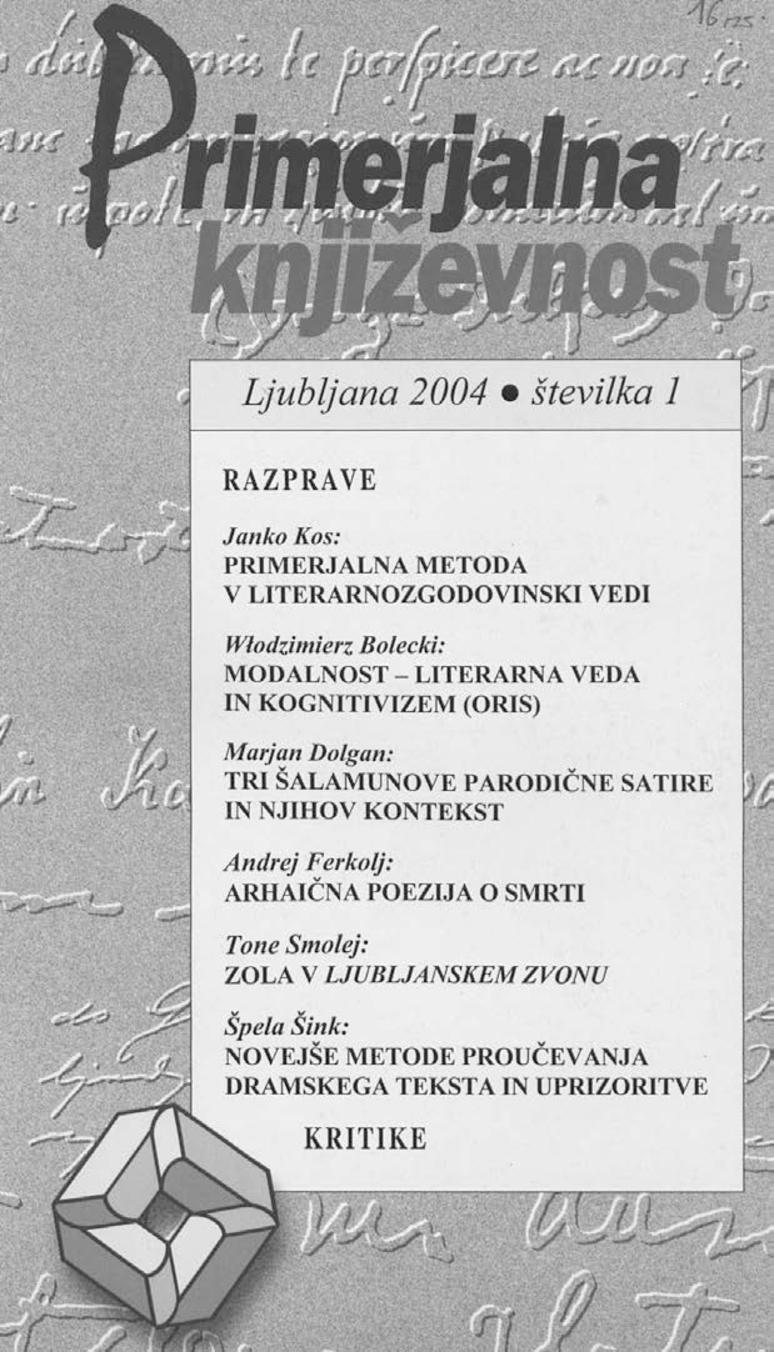Newer Methods of Researching Dramatic Texts and Theatrical Representation
Keywords:
drama theory, semiotics, dramatic text, theatrical performance, Shakespeare, William, Jovanović, Dušan, Romeo and JulietAbstract
The treatise explores the relationship between drama’s text and its theatrical application, more accurately the analysis of Shakespeare’s Romeo and Juliet and its representation by Dušan Jovanović as presented on the stage of the Slovenian National Theatre in Ljubljana. Although Jovanović follows the original Shakespearian text quite closely, the dramatic text and its theatrical application are analyzed separately to achieve better clarity. – Structuralism includes into its analysis the text and the theatrical representation of drama offering an exploration of some basic elements of the drama, as for example the actant’s models, plot, dramatic time and space. Nevertheless, it does not include some important thematic aspects of the content. – The question of the essence of Shakespeare’s drama is answered by using the method of New Historicism. This method proves to be the most appropriate mode for the analysis of renaissance dramatic literature since it exclusively explores the text and its relationship with the specific features and hidden ideology of its era. By using it, the treatise focuses on four aspects of Shakespeare’s Romeo and Juliet, which are: fragility of ideal love, realization of the presages of death, conflict between legal and legitimate, and improvisation of the main dramatis personae. – Contrary to the analysis of plain drama’s text, the analysis of the theatrical representation uses the semiotic method and some other methods related to it. These methods are significant because of their pluralism which serves as a basis of their theory. Not only do they focus on the text itself, but they also include the moments of production and reception. A similar approach is offered in the theoretical work L’analyse des spectacles written by Patrice Pavis, which serves as a fulcrum to this treatise. However, some of Pavis’ perspectives are not entirely adequate for the analysis of dramatic representation, therefore they are critically evaluated. – The conclusion deals with the formation of Jovanović’s theatrical representation and its final stage version as offered to the public. Deriving from this and previous findings, it is possible to obtain some significant differences between the drama’s text and its theatrical representation.References
BAKHTIN, Mikhail M., 1986: The Dialogic Imagination. Austin: University of Texas Press.
BELSEY, Catherine, 2002: »Ime rože ter Romeo in Julija.« Gledališki list SNG Drama Ljubljana. Št. 1. 28–31.
GREENBLATT, Stephen, 1994: »The Improvisation of Power.« V: The New hHstoricism Reader. Ur. Harold Veeser. New York: Routledge. 46–87.
GREENBLATT, Stephen, 1989: »Towards a Poetics of Culture.« V: The New Historicism Reader. Ur. Harold Veeser. New York: Routledge. 1–14.
HRIBAR, Spomenka, 2002: »Romeo in Julija – drama ljubezni in sovraštva.« Gledališki list SNG Drama Ljubljana. Št. 1. 16–20.
JOVANOVIĆ, Dušan, 1996: Paberki. Ljubljana: Mestno gledališče ljubljansko.
KOS, Janko, 1996: »K vprašanju o bistvu tragedije.« Primerjalna književnost. Št. 1. 1–16.
KRALJ, Lado, 1998: Teorija drame. Ljubljana: Državna založba Slovenije. (Literarni leksikon 44).
KRISTEVA, Julija, 2002: »Par v risu ljubezni in sovraštva.« Gledališki list SNG Drama Ljubljana. Št. 1. 23–27.
MÖDERNDORFER, Vinko, 2001: Gledališče v ogledalu: gledališka razmišljanja in travestije: 1986–1998. Maribor: Obzorja.
PAVIS, Patrice, 1996: L’analyse des spectacles. Pariz: Editions Nathan.
PFISTER, Manfred, 2001: Das Drama. Theorie und Analyse. Stuttgart: UTB.
SHAKESPEARE, William, 1991: Romeo in Julija. Ljubljana: Mladinska knjiga.
STALLYBRASS, Peter, 1998: »Transvestism and the ’Body Beneath’: Speculating on the Boy Actor.« V: Shakespeare’s Tragedies. Ur. Susan Zimmerman. London: MacMillan Press Itd. 194–211.
STANOVNIK, Majda, 1991: »Hamlet in grobarja: kraljevič, klovn in kmet.« V: 15. prevajalski zbornik. Ur. Aleš Berger, Jaroslav Skrušny in Irena Trenc Frelih. Ljubljana: Društvo slovenskih književnih prevajalcev. 7–19.
STANOVNIK, Majda, 1991: »Milan Jesih o svojem prevodu Romea in Julije.« V: 15. prevajalski zbornik. Ur. Aleš Berger, Jaroslav Skrušny in Irena Trenc-Frelih. Ljubljana: Društvo slovenskih književnih prevajalcev. 95–104.
ŠILER, Martina, 2002: »Mitologija sodobne ljubezni in smrti.« Gledališki list SNG Drama Ljubljana. Št. 1. 14–15.
UBERSFELD, Anne, 2002: Brati gledališče. Ljubljana: Mestno gledališče ljubljansko.
VEESER, Aram H., 1989: »Introduction.« V: The New Historicism Reader. Ur. Harold Veeser. New York: Routledge. VÜ–IX.
VEESER, Aram H., 1994: »The New Historicism.« V: The New Historicism Reader. Ur. Harold Veeser. New York: Routledge. 1–34.
ZIMMERMAN, Susan, 1998: »Introduction: Shakespeare’s tragedies in Postmodern Perspective.« V: Shakespeare’s Tragedies. Ur. Susan Zimmerman. London: MacMillan Press Ltd. 1–22.


